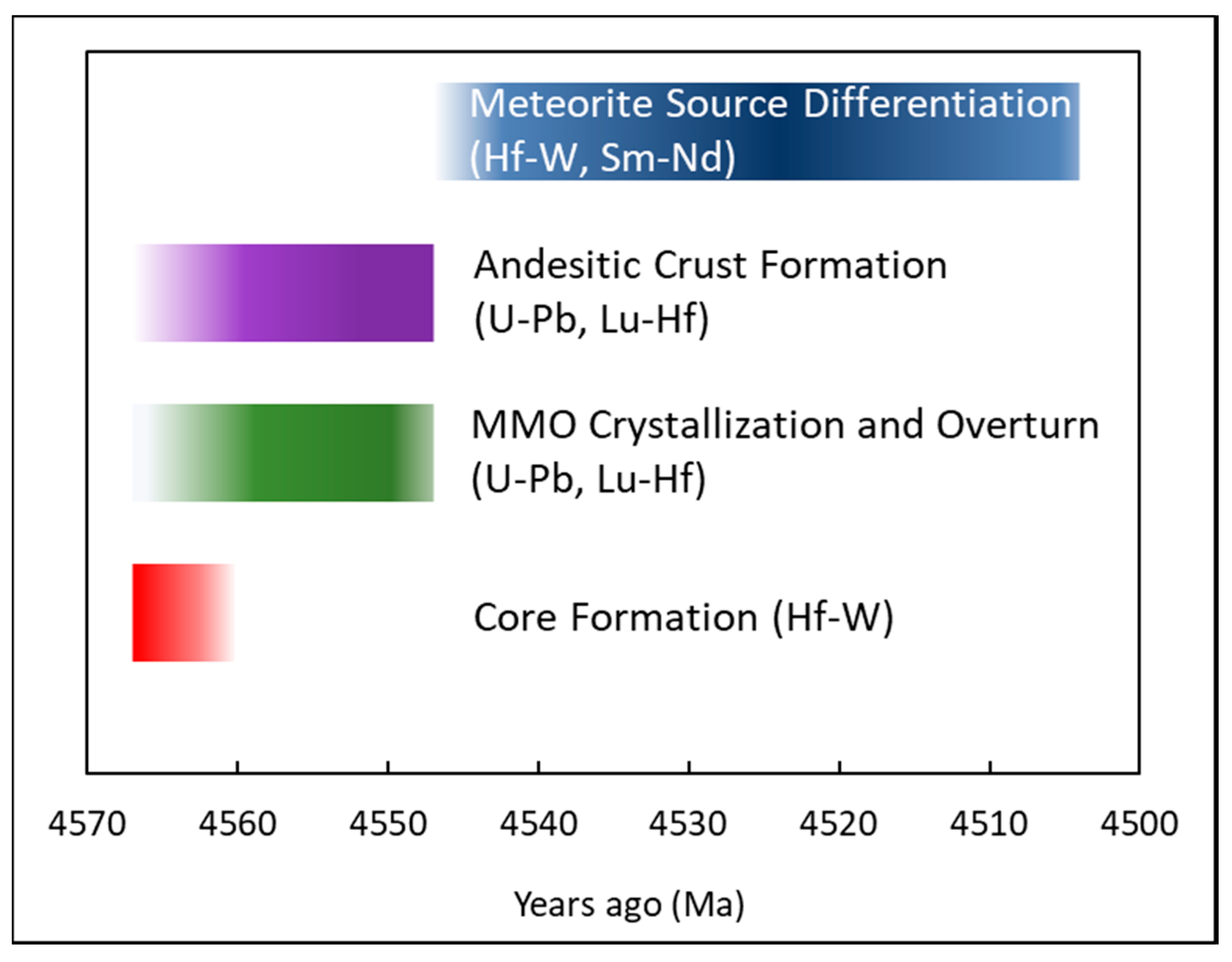Constraints on Martian Chronology from Meteorites
Abstract
1. Introduction
2. Overview of Martian Meteorites
3. Crystallization and Ejection Ages
4. Differentiation
5. Core Formation
6. Conclusions
Author Contributions
Funding
Acknowledgments
Conflicts of Interest
References
- Chambers, J.E. Planetary accretion in the inner Solar System. Earth Planet. Sci. Lett. 2004, 223, 241–252. [Google Scholar] [CrossRef]
- Raymond, S.N.; O’Brien, D.P.; Morbidelli, A.; Kaib, N.A. Building the terrestrial planets: Constrained accretion in the inner Solar System. Icarus 2009, 203, 644–662. [Google Scholar] [CrossRef]
- Dauphas, N.; Chaussidon, M. A Perspective from Extinct Radionuclides on a Young Stellar Object: The Sun and Its Accretion Disk. Annu. Rev. Earth Planet. Sci. 2011, 39, 351–386. [Google Scholar] [CrossRef]
- Crozaz, G.; Floss, C.; Wadhwa, M. Chemical alteration and REE mobilization in meteorites from hot and cold deserts. Geochim. Cosmochim. Acta 2003, 67, 4727–4741. [Google Scholar] [CrossRef]
- Treiman, A.H.; Gleason, J.D.; Bogard, D.D. The SNC meteorites are from Mars. Planet. Space Sci. 2000, 48, 1213–1230. [Google Scholar] [CrossRef]
- Clayton, R.N.; Mayeda, T.K. Oxygen isotope studies of achondrites. Geochim. Cosmochim. Acta 1996, 60, 1999–2017. [Google Scholar] [CrossRef]
- Udry, A.; Howarth, G.H.; Herd, C.; Day, J.; Lapen, T.J.; Filiberto, J. What martian meteorites reveal about the interior and surface of Mars. Earth Sp. Sci. Open Arch. 2020, 55. [Google Scholar] [CrossRef]
- McSween, H.Y. SNC meteorites: Clues to martain petrogenic evolution? Rev. Geophys. 1985, 23, 391–416. [Google Scholar] [CrossRef]
- Lapen, T.J.; Righter, M.; Brandon, A.D.; Debaille, V.; Beard, B.L.; Shafer, J.T.; Peslier, A.H. A younger age for ALH84001 and Its geochemical link to shergottite sources in mars. Science 2010, 328, 347–351. [Google Scholar] [CrossRef]
- Agee, C.B.; Wilson, N.V.; McCubbin, F.M.; Ziegler, K.; Polyak, V.J.; Sharp, Z.D.; Asmerom, Y.; Nunn, M.H.; Shaheen, R.; Thiemens, M.H.; et al. Unique meteorite from early Amazonian Mars: Water-rich basaltic breccia Northwest Africa 7034. Science 2013, 339, 780–785. [Google Scholar] [CrossRef]
- Herd, C.D.K.; Walton, E.L.; Agee, C.B.; Muttik, N.; Ziegler, K.; Shearer, C.K.; Bell, A.S.; Santos, A.R.; Burger, P.V.; Simon, J.I.; et al. The Northwest Africa 8159 martian meteorite: Expanding the martian sample suite to the early Amazonian. Geochim. Cosmochim. Acta 2017, 218, 1–26. [Google Scholar] [CrossRef]
- Lapen, T.J.; Righter, M.; Andreasen, R.; Irving, A.J.; Satkoski, A.M.; Beard, B.L.; Nishiizumi, K.; Jull, A.J.T.; Caffee, M.W. Two billion years of magmatism recorded from a single Mars meteorite ejection site. Sci. Adv. 2017, 3, 1–7. [Google Scholar] [CrossRef]
- Papike, J.J.; Karner, J.M.; Shearer, C.K.; Burger, P.V. Silicate mineralogy of martian meteorites. Geochim. Cosmochim. Acta 2009, 73, 7443–7485. [Google Scholar] [CrossRef]
- Borg, L.E.; Draper, D.S. A petrogenetic model for the origin and compositional variation of the martian basaltic meteorites. Meteorit. Planet. Sci. 2003, 38, 1713–1731. [Google Scholar] [CrossRef]
- Debaille, V.; Brandon, A.D.; Yin, Q.Z.; Jacobsen, B. Coupled 142Nd-143Nd evidence for a protracted magma ocean in Mars. Nature 2007, 450, 525–528. [Google Scholar] [CrossRef]
- Kruijer, T.S.; Kleine, T.; Borg, L.E.; Brennecka, G.A.; Irving, A.J.; Bischoff, A.; Agee, C.B. The early differentiation of Mars inferred from Hf–W chronometry. Earth Planet. Sci. Lett. 2017, 474, 345–354. [Google Scholar] [CrossRef]
- McCubbin, F.M.; Elardo, S.M.; Shearer, C.K.; Smirnov, A.; Hauri, E.H.; Draper, D.S. A petrogenetic model for the comagmatic origin of chassignites and nakhlites: Inferences from chlorine-rich minerals, petrology, and geochemistry. Meteorit. Planet. Sci. 2013, 48, 819–853. [Google Scholar] [CrossRef]
- Shearer, C.K.; Messenger, S.; Sharp, Z.D.; Burger, P.V.; Nguyen, A.N.; McCubbin, F.M. Distinct chlorine isotopic reservoirs on Mars. Implications for character, extent and relative timing of crustal interactions with mantle-derived magmas, evolution of the martian atmosphere, and the building blocks of an early Mars. Geochim. Cosmochim. Acta 2018, 234, 24–36. [Google Scholar] [CrossRef]
- Udry, A.; Day, J.M.D. 1.34 billion-year-old magmatism on Mars evaluated from the co-genetic nakhlite and chassignite meteorites. Geochim. Cosmochim. Acta 2018, 238, 292–315. [Google Scholar] [CrossRef]
- Cohen, B.E.; Mark, D.F.; Cassata, W.S.; Lee, M.R.; Tomkinson, T.; Smith, C.L. Taking the pulse of Mars via dating of a plume-fed volcano. Nat. Commun. 2017, 8, 1–8. [Google Scholar] [CrossRef]
- Borg, L.E.; Connelly, J.N.; Nyquist, L.E.; Shih, C.Y.; Wiesmann, H.; Reese, Y. The age of the carbonates in martian meteorite ALH84001. Science 1999, 286, 90–94. [Google Scholar] [CrossRef]
- Bouvier, L.C.; Costa, M.M.; Connelly, J.N.; Jensen, N.K.; Wielandt, D.; Storey, M.; Nemchin, A.A.; Whitehouse, M.J.; Snape, J.F.; Bellucci, J.J.; et al. Evidence for extremely rapid magma ocean crystallization and crust formation on Mars. Nature 2018, 558, 586–589. [Google Scholar] [CrossRef]
- Taylor, G.J.; Martel, L.M.V.; Karunatillake, S.; Gasnault, O.; Boynton, W.V. Mapping Mars geochemically. Geology 2010, 38, 183–186. [Google Scholar] [CrossRef]
- Filiberto, J. Geochemistry of Martian basalts with constraints on magma genesis. Chem. Geol. 2017, 466, 1–14. [Google Scholar] [CrossRef]
- McSween, H.Y.; Ruff, S.W.; Morris, R.V.; Bell, J.F.; Herkenhoff, K.; Gellert, R.; Stockstill, K.R.; Tornabene, L.L.; Squyres, S.W.; Crisp, J.A.; et al. Alkaline volcanic rocks from the Columbia Hills, Gusev crater, Mars. J. Geophys. Res. E Planets 2006, 111, 1–15. [Google Scholar] [CrossRef]
- Cousin, A.; Sautter, V.; Payré, V.; Forni, O.; Mangold, N.; Gasnault, O.; Le Deit, L.; Johnson, J.; Maurice, S.; Salvatore, M.; et al. Classification of igneous rocks analyzed by ChemCam at Gale crater, Mars. Icarus 2017, 288, 265–283. [Google Scholar] [CrossRef]
- Borg, L.; Drake, M.J. A review of meteorite evidence for the timing of magmatism and of surface or near-surface liquid water on Mars. J. Geophys. Res. E Planets 2005, 110, 1–10. [Google Scholar] [CrossRef]
- Cassata, W.S.; Cohen, B.E.; Mark, D.F.; Trappitsch, R.; Crow, C.A.; Wimpenny, J.; Lee, M.R.; Smith, C.L. Chronology of martian breccia NWA 7034 and the formation of the martian crustal dichotomy. Sci. Adv. 2018, 4, eaap8306. [Google Scholar] [CrossRef]
- Head, J.N.; Melosh, H.J.; Ivanov, B.A. Martian meteorite launch: High-speed ejecta from small craters. Science 2002, 298, 1752–1756. [Google Scholar] [CrossRef]
- Artemieva, N.; Ivanov, B. Launch of martian meteorites in oblique impacts. Icarus 2004, 171, 84–101. [Google Scholar] [CrossRef]
- Fritz, J.; Artemieva, N.; Greshake, A. Ejection of Martian meteorites. Meteorit. Planet. Sci. 2005, 40, 1393–1411. [Google Scholar] [CrossRef]
- Kunz, J.; Falter, M.; Jessberger, E.K. Shocked meteorites: Argon-40-argon-39 evidence for multiple impacts. Meteorit. Planet. Sci. 1997, 32, 647–670. [Google Scholar] [CrossRef]
- Crozaz, G.; Wadhwa, M. The terrestrial alteration of saharan shergottites dar al ganid 476 and 489: A case study of weathering in a hot desert environment. Geochim. Cosmochim. Acta 2001, 65, 971–978. [Google Scholar] [CrossRef]
- Marks, N.E.; Borg, L.E.; Gaffney, A.M.; DePaolo, D. The Relationship of Northwest Africa 4468 to the Other Incompatible Element-enriched Shergottites Inferred from its Rb-Sr and Sm-Nd Isotopic Systematics. In Proceedings of the 41st Lunar and Planetary Science Conference, Woodlands, TX, USA, 1–5 March 2010. [Google Scholar]
- Shafer, J.T.; Brandon, A.D.; Lapen, T.J.; Righter, M.; Peslier, A.H.; Beard, B.L. Trace element systematics and 147Sm-143Nd and 176Lu-176Hf ages of Larkman Nunatak 06319: Closed-system fractional crystallization of an enriched shergottite magma. Geochim. Cosmochim. Acta 2010, 74, 7307–7328. [Google Scholar] [CrossRef]
- Shih, C.-Y.; Nyquist, L.E.; Reese, Y. Rb-Sr and Sm-Nd Studies of Olivine-Phyric Shergottites RBT 04262 and LAR 06319: Isotopic Evidence for Relationship to Enriched Basaltic Shergottites. Lunar Planet. Inst. Sci. Conf. Abstr. 2009, 40, 1360. [Google Scholar]
- Shih, C.-Y.; Nyquist, L.E.; Wiesmann, H.; Barrat, J.A. Age and Petrogenesis of Picritic Shergottite NWA1068: Sm-Nd and Rb-Sr Isotopic Studies. In Proceedings of the 34th Annual Lunar and Planetary Science Conference, Woodlands, TX, USA, 21 August 2003; p. 1439. [Google Scholar]
- Ferdous, J.; Brandon, A.D.; Peslier, A.H.; Pirotte, Z. Evaluating crustal contributions to enriched shergottites from the petrology, trace elements, and Rb-Sr and Sm-Nd isotope systematics of Northwest Africa 856. Geochim. Cosmochim. Acta 2017, 211, 280–306. [Google Scholar] [CrossRef]
- Shih, C.Y.; Nyquist, L.E.; Bogard, D.D.; McKay, G.A.; Wooden, J.L.; Bansal, B.M.; Wiesmann, H. Chronology and petrogenesis of young achondrites, Shergotty, Zagami, and ALHA77005: Late magmatism on a geologically active planet. Geochim. Cosmochim. Acta 1982, 46, 2323–2344. [Google Scholar] [CrossRef]
- Borg, L.E.; Edmunson, J.E.; Asmerom, Y. Constraints on the U-Pb isotopic systematics of Mars inferred from a combined U-Pb, Rb-Sr, and Sm-Nd isotopic study of the Martian meteorite Zagami. Geochim. Cosmochim. Acta 2005, 69, 5819–5830. [Google Scholar] [CrossRef]
- Combs, L.M.; Udry, A.; Howarth, G.H.; Righter, M.; Lapen, T.J.; Gross, J.; Ross, D.K.; Rahib, R.R.; Day, J.M.D. Petrology of the enriched poikilitic shergottite Northwest Africa 10169: Insight into the martian interior. Geochim. Cosmochim. Acta 2019, 266, 435–462. [Google Scholar] [CrossRef]
- Moser, D.E.; Chamberlain, K.R.; Tait, K.T.; Schmitt, A.K.; Darling, J.R.; Barker, I.R.; Hyde, B.C. Solving the Martian meteorite age conundrum using micro-baddeleyite and launch-generated zircon. Nature 2013, 499, 454–457. [Google Scholar] [CrossRef]
- Borg, L.E.; Nyquist, L.E.; Wiesmann, H.; Reese, Y. Constraints on the petrogenesis of Martian meteorites from the Rb-Sr and Sm-Nd isotopic systematics of the lherzolitic shergottites ALH77005 and LEW88516. Geochim. Cosmochim. Acta 2002, 66, 2037–2053. [Google Scholar] [CrossRef]
- Nyquist, L.E.; Bogard, D.D.; Shih, C.Y.; Greshake, A.; Stöffler, D.; Eugster, O. Ages and geologic histories of martian meteorites. Space Sci. Rev. 2001, 96, 105–164. [Google Scholar] [CrossRef]
- Liu, T.; Li, C.; Lin, Y. Rb-Sr and Sm-Nd isotopic systematics of the lherzolitic shergottite GRV 99027. Meteorit. Planet. Sci. 2011, 46, 681–689. [Google Scholar] [CrossRef]
- Nyquist, L.E.; Bogard, D.D.; Shih, C.Y.; Park, J.; Reese, Y.D.; Irving, A.J. Concordant Rb-Sr, Sm-Nd, and Ar-Ar ages for Northwest Africa 1460: A 346 Ma old basaltic shergottite related to “lherzolitic” shergottites. Geochim. Cosmochim. Acta 2009, 73, 4288–4309. [Google Scholar] [CrossRef]
- Misawa, K.; Park, J.; Shih, C.Y.; Reese, Y.; Bogard, D.D.; Nyquist, L.E. Rb-Sr, Sm-Nd, and Ar-Ar isotopic systematics of lherzolitic shergottite Yamato 000097. Polar Sci. 2008, 2, 163–174. [Google Scholar] [CrossRef]
- Morikawa, N.; Misawa, K.; Kondorosi, G.; Premo, W.R.; Tatsumoto, M.; Nakamura, N. Rb-Sr isotopic systematics of lherzolitic shergottite. Antarct. Meteor. Res. 2001, 14, 47–60. [Google Scholar]
- Shih, C.Y.; Nyquist, L.E.; Reese, Y.; Misawa, K. Sm-Nd and Rb-Sr studies of lherzolitic shergottite Yamato 984028. Polar Sci. 2011, 4, 515–529. [Google Scholar] [CrossRef]
- Borg, L.E.; Nyquist, L.E.; Wiesmann, H.; Shih, C.Y.; Reese, Y. The age of Dar al Gani 476 and the differentation history of the martian meteorites inferred from their radiogenic isotopic systematics. Geochim. Cosmochim. Acta 2003, 67, 3519–3536. [Google Scholar] [CrossRef]
- Symes, S.J.; Borg, L.E.; Shearer, C.K.; Asmerom, Y.; Irving, A.J. Geochronology of NWA 1195 based on Rb-Sr and Sm-Nd Isotopic Systematics. In Proceedings of the 36th Annual Lunar and Planetary Science Conference, Woodlands, TX, USA, 14–18 March 2005; p. 1435. [Google Scholar]
- Borg, L.E.; Nyquist, L.E.; Taylor, L.A.; Wiesmann, H.; Shih, C.Y. Constraints on Martian differentiation processes from Rb-Sr and Sm-Nd isotopic analyses of the basaltic shergottite QUE 94201. Geochim. Cosmochim. Acta 1997, 61, 4915–4931. [Google Scholar] [CrossRef]
- Shih, Y.; Nyquist, L.E.; Reese, Y. Rb-Sr and Sm-Nd Isotopic Studies of Martian Depleted Shergottites SaU 094/005. In Proceedings of the 38th Annual Lunar and Planetary Science Conference, Woodlands, TX, USA, 1 January 2007. Abstract 1745. [Google Scholar]
- Brennecka, G.A.; Borg, L.E.; Wadhwa, M. Insights into the Martian mantle: The age and isotopics of the meteorite fall Tissint. Meteorit. Planet. Sci. 2014, 49, 412–418. [Google Scholar] [CrossRef]
- Shih, C.-Y.; Nyquist, L.E.; Wiesmann, H.; Misawa, K. Rb-Sr and Sm-Nd Isotopic Studies of Shergottite Y980459 and a Petrogenetic Link Between Depleted Shergottites and Nakhlites. In Proceedings of the 35th Lunar and Planetary Science Conference, Woodlands, TX, USA, 15–19 March 2004; pp. 8–9. [Google Scholar]
- Herzog, G.F.; Caffee, M.W. Cosmic-Ray Exposure Ages of Meteorites. In Treatise on Geochemistry; Elsevier Ltd.: Amsterdam, The Netherlands, 2014; Volume 1–9, pp. 419–453. [Google Scholar]
- Wieler, R.; Huber, L.; Busemann, H.; Seiler, S.; Leya, I.; Maden, C.; Masarik, J.; Meier, M.M.M.; Nagao, K.; Trappitsch, R.; et al. Noble gases in 18 Martian meteorites and angrite Northwest Africa 7812-Exposure ages, trapped gases, and a re-evaluation of the evidence for solar cosmic ray-produced neon in shergottites and other achondrites. Meteorit. Planet. Sci. 2016, 51, 407–428. [Google Scholar] [CrossRef]
- Bouvier, A.; Blichert-Toft, J.; Vervoort, J.D.; Albarède, F. The age of SNC meteorites and the antiquity of the Martian surface. Earth Planet. Sci. Lett. 2005, 240, 221–233. [Google Scholar] [CrossRef]
- Bouvier, A.; Blichert-Toft, J.; Vervoort, J.D.; Gillet, P.; Albarède, F. The case for old basaltic shergottites. Earth Planet. Sci. Lett. 2008, 266, 105–124. [Google Scholar] [CrossRef]
- Bouvier, A.; Blichert-Toft, J.; Albarède, F. Martian meteorite chronology and the evolution of the interior of Mars. Earth Planet. Sci. Lett. 2009, 280, 285–295. [Google Scholar] [CrossRef]
- Hartmann, W.K.; Neukum, G. Cratering chronology and the evolution of Mars. Space Sci. Rev. 2001, 96, 165–194. [Google Scholar] [CrossRef]
- Bellucci, J.J.; Nemchin, A.A.; Whitehouse, M.J.; Snape, J.F.; Bland, P.; Benedix, G.K. The Pb isotopic evolution of the Martian mantle constrained by initial Pb in Martian meteorites. J. Geophys. Res. Planets 2015, 120, 2224–2240. [Google Scholar] [CrossRef]
- Bellucci, J.J.; Nemchin, A.A.; Whitehouse, M.J.; Snape, J.F.; Kielman, R.B.; Bland, P.A.; Benedix, G.K. A Pb isotopic resolution to the Martian meteorite age paradox. Earth Planet. Sci. Lett. 2016, 433, 241–248. [Google Scholar] [CrossRef]
- Bellucci, J.J.; Nemchin, A.A.; Whitehouse, M.J.; Humayun, M.; Hewins, R.; Zanda, B. Pb-isotopic evidence for an early, enriched crust on Mars. Earth Planet. Sci. Lett. 2015, 410, 34–41. [Google Scholar] [CrossRef]
- Nakamura, N.; Unruh, D.M.; Tatsumoto, M.; Hutchison, R. Origin and evolution of the Nakhla meteorite inferred from the Sm-Nd and U-Pb systematics and REE, Ba, Sr, Rb and K abundances. Geochim. Cosmochim. Acta 1982, 46, 1555–1573. [Google Scholar] [CrossRef]
- Shih, C.-Y.; Nyquist, L.E.; Reese, Y.; Wiesmann, H. The Chronology of the Nakhlite, Lafayette: Rb-Sr and Sm-Nd Isotopic Ages. In Proceedings of the 29th Lunar and Planetary Science Conference, Woodlands, TX, USA, 16–20 March 1998; Volume 1, pp. 14–15. [Google Scholar]
- Shih, C.Y.; Nyquist, L.E.; Wiesmann, H. Samarium-neodymium and rubidium-strontium systematics of nakhlite Governador Valadares. Meteorit. Planet. Sci. 1999, 34, 647–655. [Google Scholar] [CrossRef]
- Misawa, K.; Shih, C.Y.; Reese, Y.; Bogard, D.D.; Nyquist, L.E. Rb-Sr, Sm-Nd and Ar-Ar isotopic systematics of Martian dunite Chassigny. Earth Planet. Sci. Lett. 2006, 246, 90–101. [Google Scholar] [CrossRef]
- Treiman, A.H. The nakhlite meteorites: Augite-rich igneous rocks from Mars. Geochemistry 2005, 65, 203–270. [Google Scholar] [CrossRef]
- Humayun, M.; Nemchin, A.; Zanda, B.; Hewins, R.H.; Grange, M.; Kennedy, A.; Lorand, J.P.; Göpel, C.; Fieni, C.; Pont, S.; et al. Origin and age of the earliest Martian crust from meteorite NWA 7533. Nature 2013, 503, 513–516. [Google Scholar] [CrossRef] [PubMed]
- Nyquist, L.E.; Shih, C.Y.; Mccubbin, F.M.; Santos, A.R.; Shearer, C.K.; Peng, Z.X.; Burger, P.V.; Agee, C.B. Rb-Sr and Sm-Nd isotopic and REE studies of igneous components in the bulk matrix domain of Martian breccia Northwest Africa 7034. Meteorit. Planet. Sci. 2016, 51, 483–498. [Google Scholar] [CrossRef]
- McCubbin, F.M.; Boyce, J.W.; Novák-Szabó, T.; Santos, A.R.; Tartèse, R.; Muttik, N.; Domokos, G.; Vazquez, J.; Keller, L.P.; Moser, D.E.; et al. Geologic history of Martian regolith breccia Northwest Africa 7034: Evidence for hydrothermal activity and lithologic diversity in the Martian crust. J. Geophys. Res. Planets 2016, 121, 2120–2149. [Google Scholar] [CrossRef]
- Moser, D.E.; Arcuri, G.A.; Reinhard, D.A.; White, L.F.; Darling, J.R.; Barker, I.R.; Larson, D.J.; Irving, A.J.; McCubbin, F.M.; Tait, K.T.; et al. Decline of giant impacts on Mars by 4.48 billion years ago and an early opportunity for habitability. Nat. Geosci. 2019, 12, 522–527. [Google Scholar] [CrossRef]
- Abramov, O.; Kring, D.A. Impact-induced hydrothermal activity on early Mars. J. Geophys. Res. E Planets 2005, 110, 1–19. [Google Scholar] [CrossRef]
- Cartwright, J.A.; Ott, U.; Herrmann, S.; Agee, C.B. Modern atmospheric signatures in 4.4 Ga Martian meteorite NWA 7034. Earth Planet. Sci. Lett. 2014, 400, 77–87. [Google Scholar] [CrossRef]
- Borg, L.E.; Gaffney, A.M.; DePaolo, D. Preliminary Age of Martian Meteorite Northwest Africa 4468 and Its Relationship to the Other Incompatible-Element-enriched Shergottites. In Proceedings of the 39th Lunar and Planetary Science Conference, Woodlands, TX, USA, 10–14 March 2008; p. 1851. [Google Scholar]
- Carlson, R.W.; Irving, A.J. Pb-Hf-Sr-Nd isotopic systematics and age of nakhlite NWA 998. In Proceedings of the 35th Lunar and Planetary Science Conference, Woodlands, TX, USA, 15–19 March 2004; p. A1442. [Google Scholar]
- Herd, C.D.K.; Borg, L.E.; Jones, J.H.; Papike, J.J. Oxygen fugacity and geochemical variations in the martian basalts: Implications for martian basalt petrogenesis and the oxidation state of the upper mantle of Mars. Geochim. Cosmochim. Acta 2002, 66, 2025–2036. [Google Scholar] [CrossRef]
- Papanastassiou, D.A.; Wasserburg, G.J. Initial strontium isotopic abundances and the resolution of small time differences in the formation of planetary objects. Earth Planet. Sci. Lett. 1968, 5, 361–376. [Google Scholar] [CrossRef]
- Armytage, R.M.G.; Debaille, V.; Brandon, A.D.; Agee, C.B. A complex history of silicate differentiation of Mars from Nd and Hf isotopes in crustal breccia NWA 7034. Earth Planet. Sci. Lett. 2018, 502, 274–283. [Google Scholar] [CrossRef]
- Dreibus, G.; Wanke, H. Mars, a volatile-rich planet. Meteoritics 1985, 20, 367–381. [Google Scholar] [CrossRef]
- Lodders, K.; Fegley, B. An oxygen isotope model for the composition of Mars. Icarus 1997, 126, 373–394. [Google Scholar] [CrossRef]
- Draper, D.S.; Xirouchakis, D.; Agee, C.B. Trace element partitioning between garnet and chondritic melt from 5 to 9 GPa: Implications for the onset of the majorite transition in the martian mantle. Phys. Earth Planet. Inter. 2003, 139, 149–169. [Google Scholar] [CrossRef]
- McSween, H.Y.J.; Lundberg, L.; Crozaz, G. Crystallization of the ALHA77005 Shergottite: How is a Closed System. In Proceedings of the 19th Lunar and Planetary Science Conference, Woodlands, TX, USA, 14–18 March 1988. [Google Scholar] [CrossRef]
- Kinoshita, N.; Paul, M.; Kashiv, Y.; Collon, P.; Deibel, C.M.; DiGiovine, B.; Greene, J.P.; Henderson, D.J.; Jiang, C.L.; Marley, S.T.; et al. A shorter 146Sm half-life measured and implications for 146Sm-142Nd chronology in the solar system. Science 2012, 335, 1614–1617. [Google Scholar] [CrossRef]
- Villa, I.M.; Holden, N.E.; Possolo, A.; Ickert, R.B.; Hibbert, D.B.; Renne, P.R. IUPAC-IUGS recommendation on the half-lives of 147Sm and 146Sm. Geochim. Cosmochim. Acta 2020, 285, 70–77. [Google Scholar] [CrossRef]
- Borg, L.E.; Brennecka, G.A.; Symes, S.J.K. Accretion timescale and impact history of Mars deduced from the isotopic systematics of martian meteorites. Geochim. Cosmochim. Acta 2016, 175, 150–167. [Google Scholar] [CrossRef]
- Caro, G.; Bourdon, B.; Halliday, A.N.; Quitté, G. Super-chondritic Sm/Nd ratios in Mars, the Earth and the Moon. Nature 2008, 452, 336–339. [Google Scholar] [CrossRef]
- Debaille, V.; Brandon, A.D.; Oneill, C.; Yin, Q.Z.; Jacobsen, B. Early martian mantle overturn inferred from isotopic composition of nakhlite meteorites. Nat. Geosci. 2009, 2, 548–552. [Google Scholar] [CrossRef]
- Andrews-Hanna, J.C.; Zuber, M.T.; Banerdt, W.B. The Borealis basin and the origin of the martian crustal dichotomy. Nature 2008, 453, 1212–1215. [Google Scholar] [CrossRef]
- Elkins-Tanton, L.T.; Hess, P.C.; Parmentier, E.M. Possible formation of ancient crust on Mars through magma ocean processes. J. Geophys. Res. E Planets 2005, 110, 1–11. [Google Scholar] [CrossRef]
- Scheinberg, A.; Elkins-Tanton, L.T.; Zhong, S.J. Timescale and morphology of Martian mantle overturn immediately following magma ocean solidification. J. Geophys. Res. E Planets 2014, 119, 454–467. [Google Scholar] [CrossRef]
- Barnes, J.J.; McCubbin, F.M.; Santos, A.R.; Day, J.M.D.; Boyce, J.W.; Schwenzer, S.P.; Ott, U.; Franchi, I.A.; Messenger, S.; Anand, M.; et al. Multiple early-formed water reservoirs in the interior of Mars. Nat. Geosci. 2020, 13, 260–264. [Google Scholar] [CrossRef]
- Foley, C.N.; Wadhwa, M.; Borg, L.E.; Janney, P.E.; Hines, R.; Grove, T.L. The early differentiation history of Mars from 182W-142Nd isotope systematics in the SNC meteorites. Geochim. Cosmochim. Acta 2005, 69, 4557–4571. [Google Scholar] [CrossRef]
- Kleine, T.; Mezger, K.; Münker, C.; Palme, H.; Bischoff, A. 182Hf-182W isotope systematics of chondrites, eucrites, and martian meteorites: Chronology of core formation and early mantle differentiation in Vesta and Mars. Geochim. Cosmochim. Acta 2004, 68, 2935–2946. [Google Scholar] [CrossRef]
- Righter, K.; Shearer, C.K. Magmatic fractionation of Hf and W: Constraints on the timing of core formation and differentiation in the Moon and Mars. Geochim. Cosmochim. Acta 2003, 67, 2497–2507. [Google Scholar] [CrossRef]
- Nimmo, F.; Kleine, T. How rapidly did Mars accrete? Uncertainties in the Hf-W timing of core formation. Icarus 2007, 191, 497–504. [Google Scholar] [CrossRef]
- Dauphas, N.; Pourmand, A. Hf-W-Th evidence for rapid growth of Mars and its status as a planetary embryo. Nature 2011, 473, 489–492. [Google Scholar] [CrossRef]
- Bellucci, J.J.; Nemchin, A.A.; Whitehouse, M.J.; Snape, J.F.; Bland, P.; Benedix, G.K.; Roszjar, J. Pb evolution in the Martian mantle. Earth Planet. Sci. Lett. 2018, 485, 79–87. [Google Scholar] [CrossRef]
- Debaille, V.; Yin, Q.Z.; Brandon, A.D.; Jacobsen, B. Martian mantle mineralogy investigated by the 176Lu-176Hf and 147Sm-143Nd systematics of shergottites. Earth Planet. Sci. Lett. 2008, 269, 186–199. [Google Scholar] [CrossRef]
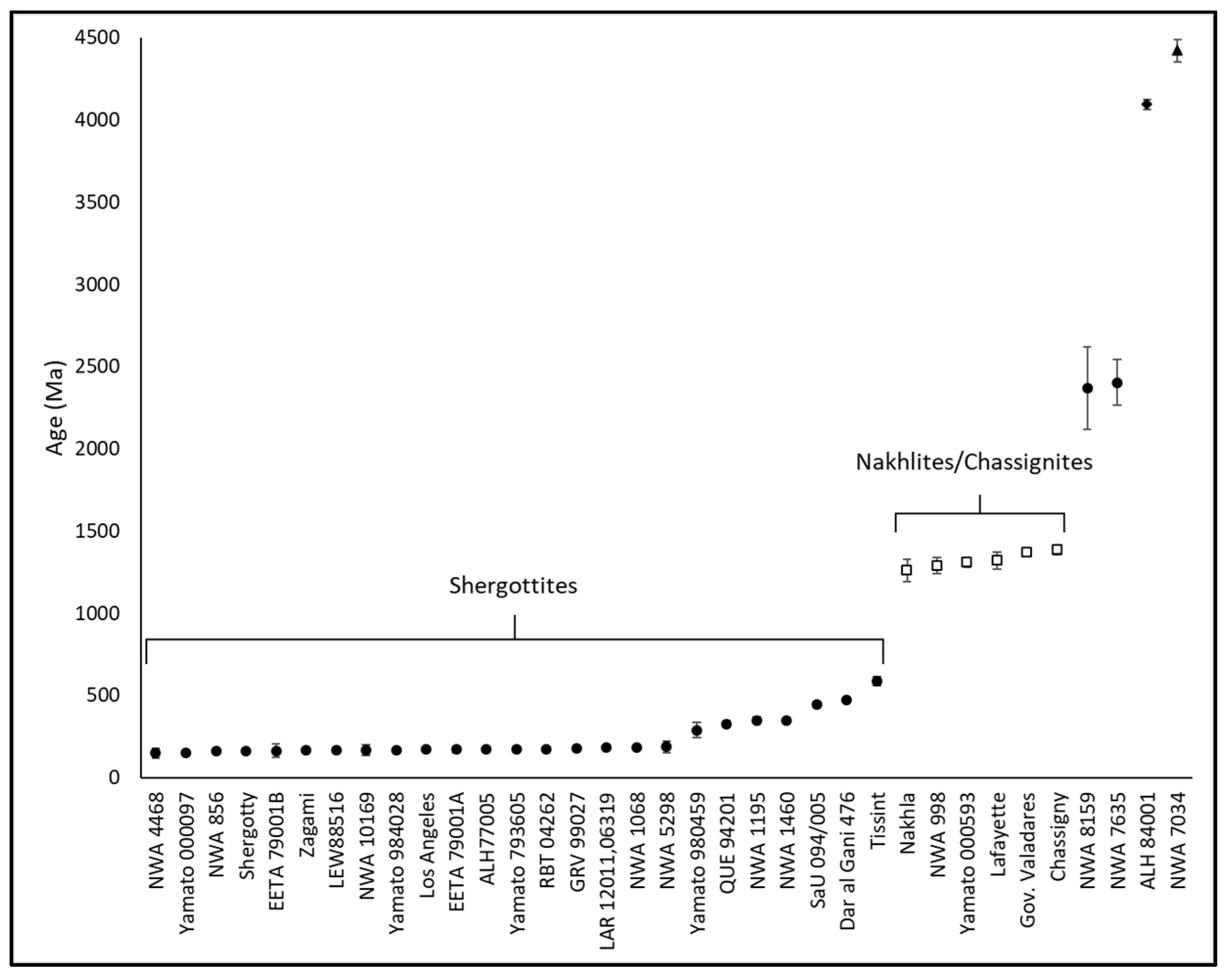
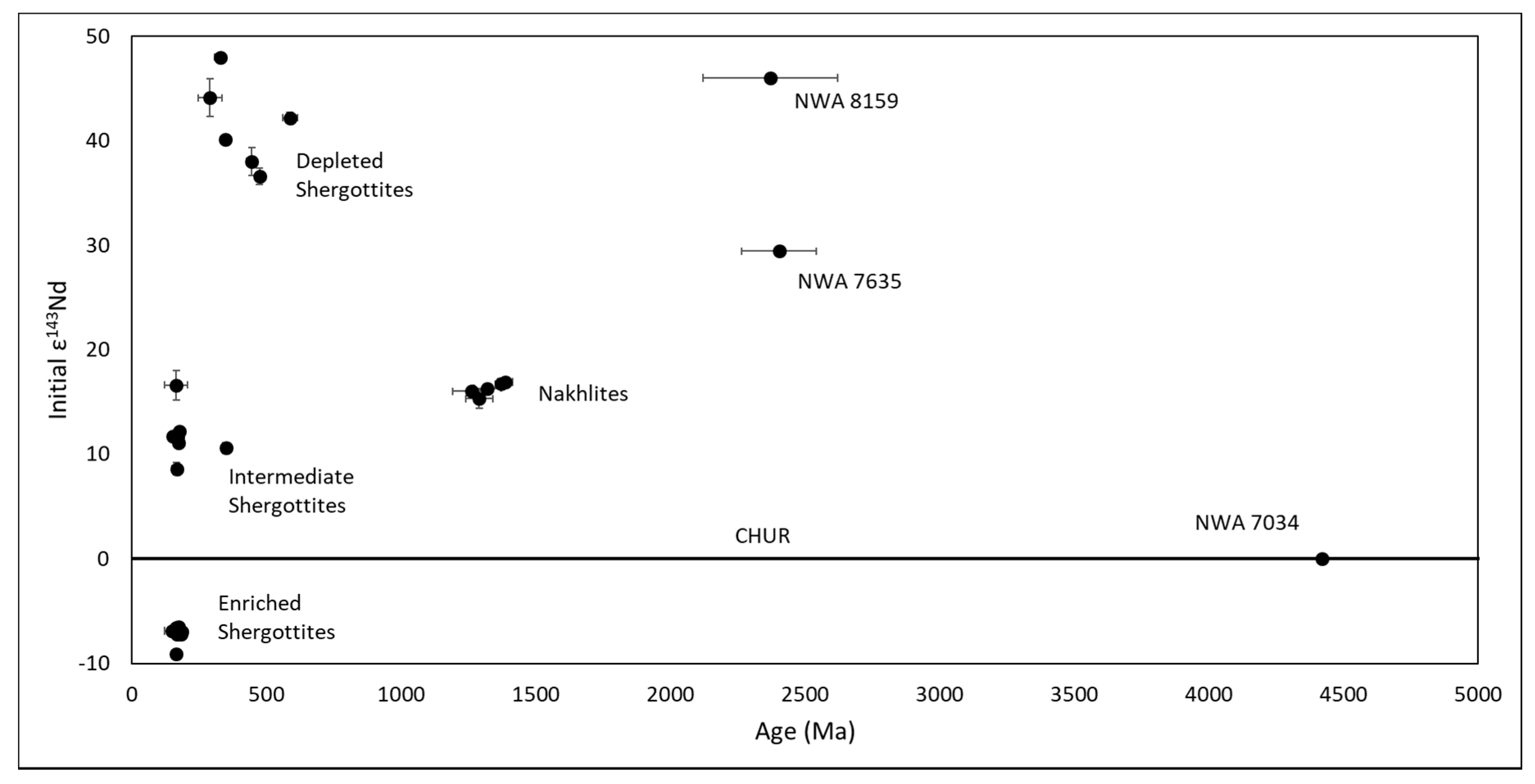
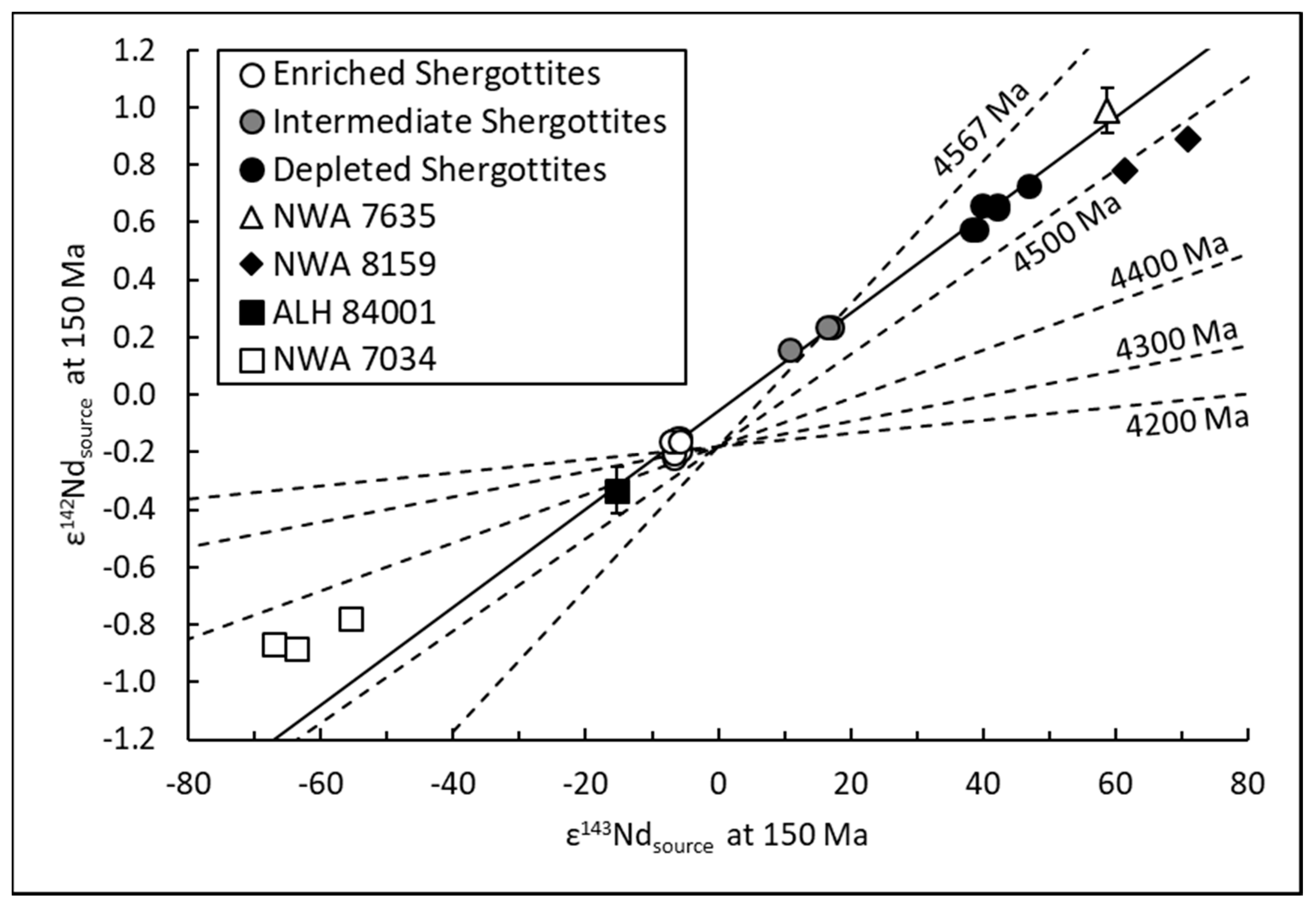
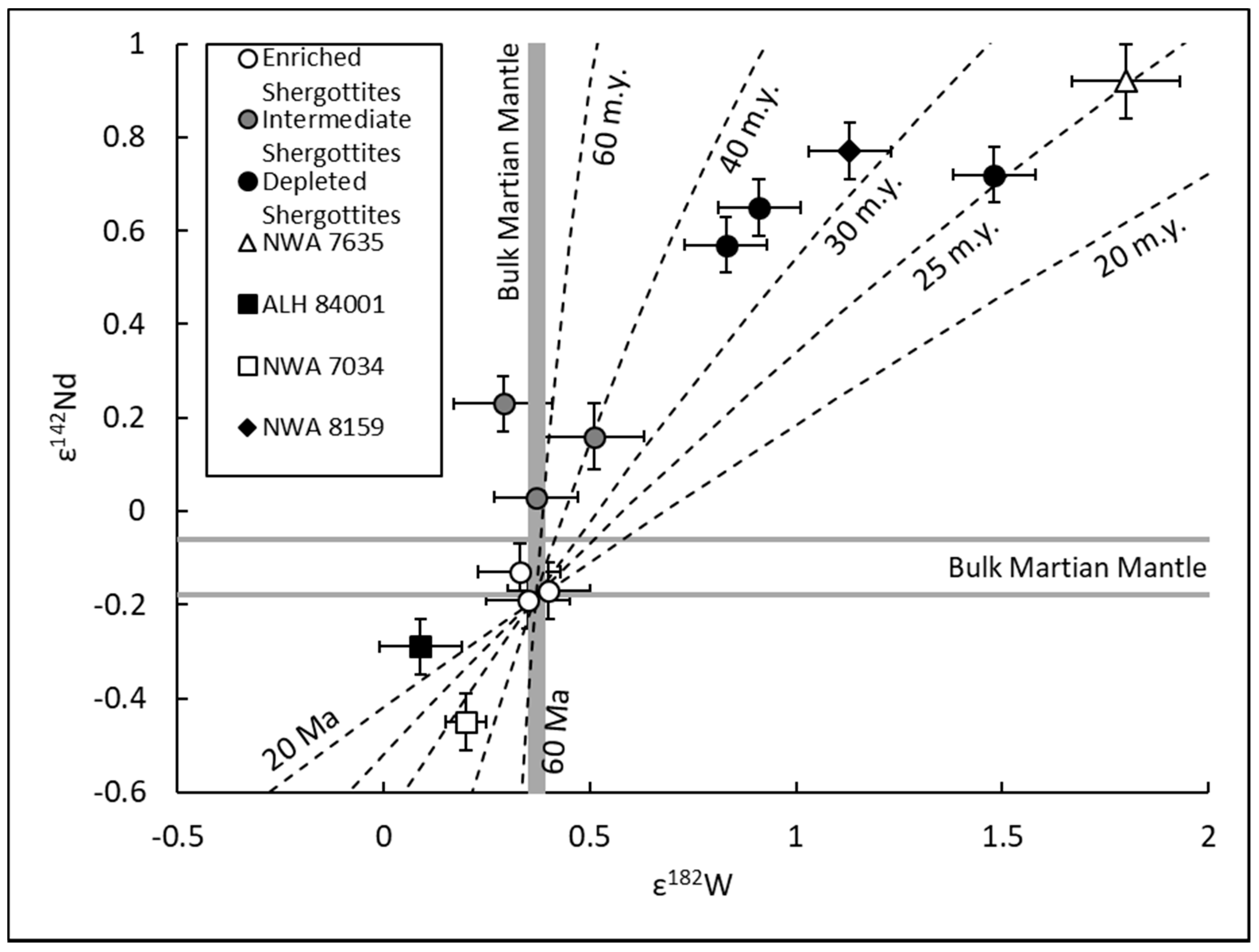
| Meteorites | Ages | Rock Type(s) | Geochemistry |
|---|---|---|---|
| Shergottites | ~150–600 Ma; ~2400 Ma | Gabbro, diabase, basalt | Depleted to Enriched in LREE |
| Nakhlites | ~1300 Ma | Augite and olivine cumulate | Enriched in REE and LREE |
| Chassignites | ~1300 Ma | Dunite | Enriched in LREE |
| NWA 8159 | ~2300 Ma | Augite basalt | Depleted in LREE |
| ALH 84001 | ~4100 Ma | Orthopyroxenite | Nearly chondritic REE |
| NWA 7034 and pairs | ~4500 Ma | Polymict igneous breccia | Enriched in REE and LREE |
Publisher’s Note: MDPI stays neutral with regard to jurisdictional claims in published maps and institutional affiliations. |
© 2020 by the authors. Licensee MDPI, Basel, Switzerland. This article is an open access article distributed under the terms and conditions of the Creative Commons Attribution (CC BY) license (http://creativecommons.org/licenses/by/4.0/).
Share and Cite
Váci, Z.; Agee, C. Constraints on Martian Chronology from Meteorites. Geosciences 2020, 10, 455. https://doi.org/10.3390/geosciences10110455
Váci Z, Agee C. Constraints on Martian Chronology from Meteorites. Geosciences. 2020; 10(11):455. https://doi.org/10.3390/geosciences10110455
Chicago/Turabian StyleVáci, Zoltán, and Carl Agee. 2020. "Constraints on Martian Chronology from Meteorites" Geosciences 10, no. 11: 455. https://doi.org/10.3390/geosciences10110455
APA StyleVáci, Z., & Agee, C. (2020). Constraints on Martian Chronology from Meteorites. Geosciences, 10(11), 455. https://doi.org/10.3390/geosciences10110455




